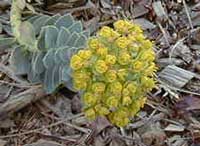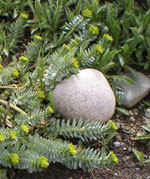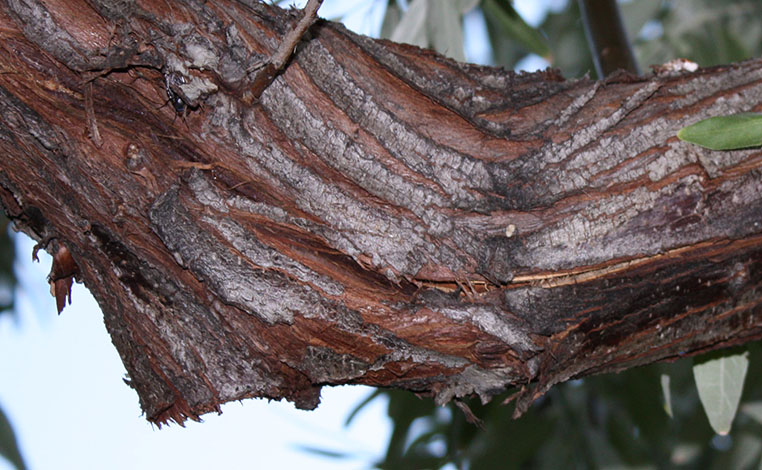Myrtle spurge
Euphorbia myrsinites
Keys to Identification
- This perennial weed is often found in rock gardens and is moving into natural areas where it has the potential to do enormous environmental damage.
- Although easily removed by hand, this member of the spurge family (Euphorbiaceae), contains a milky sap that is caustic to skin and eyes.
- Blue-green leaves clasp fleshy stems which trail along the ground. Inconspicuous yellow-green flowers are surrounded by heart shaped bracts
This information courtesy of the Colorado Natural Areas Program
Family
Spurge (Euphorbiaceae)
Other Names
Creeping spurge, donkeytail
USDA Code
EUMY2
Legal Status
Colorado Noxious Weed List A
Identification
Lifecycle
Perennial
Growth form
Forb
Flower
Yellow-green flower-like bracts appear in early spring.
Seeds/Fruit
Hard, round.
Leaves
The plant produces trailing stems of fleshy, blue-green alternate leaves.
Stems
Mature plants are 4-6 in tall and spread up to 18 in laterally.
Roots
Taproot.
Seedling
No information available.
Other
The plant exudes a milky sap that can be irritating to the skin.
Similar Species
Exotics
Non-flowering stems may sometimes be mistaken for Dalmatian toadflax.
Natives
None known.
Impacts
Agricultural
Myrtle spurge plants exude a milky sap that is considered toxic and may cause skin irritations and in extreme cases, livestock poisoning. Livestock and animals generally avoid myrtle spurge and large infestations can reduce forage production. Myrtle spurge does not tolerate frequent cultivation and therefore is not a problem in crops.
Ecological
Can inhabit disturbed ground and exclude native plants in remote rocky locations.
Human
Milky latex can cause skin irritation.
Habitat and Distribution
General requirements
Myrtle spurge prefers dry to moist, well-drained soils, in areas that receive partial shade to full sun. It is mainly an escaped ornamental that inhabits disturbed areas and waste places.
Distribution
Historical
Native to Eurasia.
General requirements
Biology/Ecology
Life cycle
Myrtle spurge is a perennial that produces new stems from the center (tap root) each year. Plants flower in early spring.
Mode of reproduction
Seed.
References
Stahevitch, A.E., C.W. Crompton, and W.A. Wojtas. The biology of Canadian weeds. 85. Euphorbia cyparissias L. Canadian Journal of Plant Science 68:175-191.
Whitson, T.D.(ed.), L.C. Burrill, S.A. Dewey, D.W. Cudney, B.E. Nelson, R.D. Lee, R. Parker. 1996. Euphorbia spp. Weeds of the West. Western Society of Weed Science, in cooperation with the Western United States Land Grant Universities Cooperative Extension Services, Newark CA. pg. 312.



